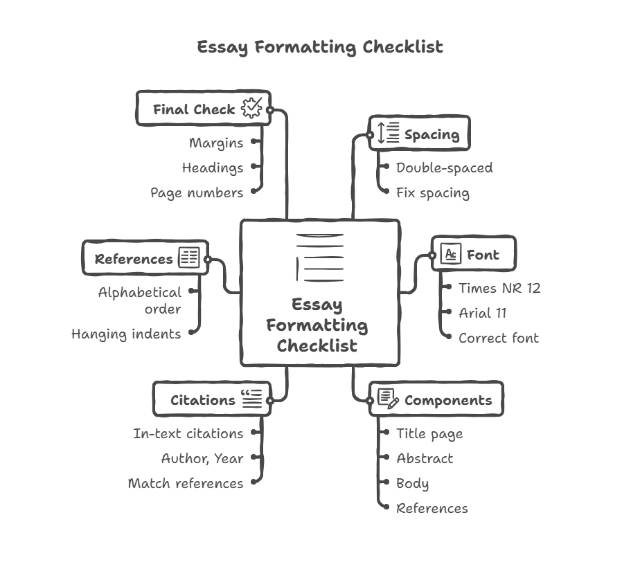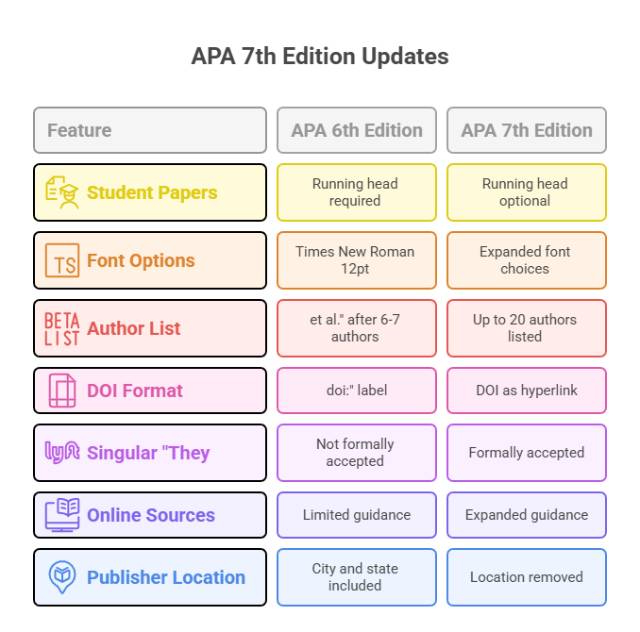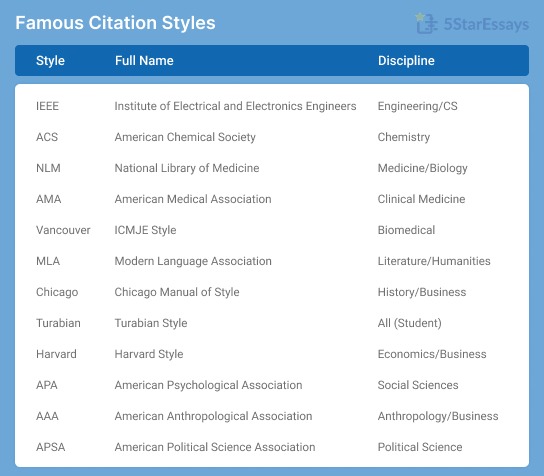APA Format Explained (7th Edition)
APA format is the official citation style of the American Psychological Association, last updated in its 7th edition, published in 2019. This standardized system tells writers exactly how to credit sources in psychology, education, sociology, business, nursing, and related fields.
The core principle of APA format is to emphasize publication dates. Social sciences build on recent research, so readers need to quickly assess whether sources are up to date. When you cite (Smith, 2024), readers immediately know this source is recent and relevant. Students sometimes confuse APA with other citation styles. This differs from humanities citation styles that prioritize page numbers over dates. For better understanding, you can review our citation style guide.
APA format consists of two main components working together. In-text citations appear within your paper's body, providing brief source identification like (Johnson, 2023) or (Martinez, 2024, p. 45). The References page at your paper's end lists complete publication details for every source you cited, alphabetized by author's last name.
The 7th edition introduced significant changes, making APA more accessible for students. Student papers no longer require running heads. You can use more readable fonts beyond Times New Roman, including Calibri, Arial, and Georgia. DOI formatting simplified to https://doi.org/ format. The manual accepts singular "they" as a pronoun and provides updated guidance for citing social media, ebooks, and online sources.
Understanding APA's logic helps you apply rules correctly rather than just memorizing formats. Social science research relies on replication and building on prior studies. Precise citations enable other researchers to locate your exact sources, verify your findings, and extend your work. Proper APA format demonstrates your engagement with scholarly literature and positions your work within ongoing academic conversations.
If you're writing literature papers, you likely need MLA format instead, which uses author-page citations without dates. History papers often require the Chicago style with footnotes. Engineering uses IEEE format with numbered citations. Always verify which style your instructor requires before you start writing.
APA 7th Edition Paper Format
Proper APA paper formatting creates a professional, readable document that meets academic standards. Follow these specifications for every APA paper unless your instructor specifies otherwise.
Font and Text Formatting
1. Font choices: APA 7th edition expanded font options beyond the traditional Times New Roman. You can now use any readable, accessible font:
- Times New Roman: 12 pt (traditional choice)
- Calibri: 11 pt (modern, clean)
- Arial: 11 pt (sans-serif readability)
- Georgia: 11 pt (web-optimized)
- Lucida Sans Unicode: 10 pt
Choose one font and use it consistently throughout your entire paper, including the title page, body text, headings, and References page.
2. Line spacing: Double-space everything—body text, headings, block quotes, References page entries, and table titles. No extra spaces between paragraphs or sections. Your word processor's default double-spacing setting works perfectly.
3. Margins: Set 1-inch margins on all four sides (top, bottom, left, right). Do not justify text; use left alignment with a ragged right edge, which improves readability.
4. Paragraph indentation: Indent the first line of every paragraph 0.5 inch using your word processor's Tab key. Do not indent the abstract, block quotes (indent these 0.5 inch from the left margin), or References entries (use hanging indent instead).
Page Numbers and Headers
Student papers: Include only page numbers in the top right corner, 0.5 inch from the top. Number every page, including the title page, which is page 1.
Professional papers: Add a running head with a shortened paper title (maximum 50 characters) in the header, flush left, with the page number flush right. Most students don't need running heads unless specifically preparing work for publication.
Document Margins and Alignment
Leave 1-inch margins on all sides without exception. If your paper will be bound, check with your instructor about whether you need a slightly wider left margin for binding. Otherwise, keep uniform 1-inch margins throughout.
Understanding these basics prevents formatting errors that immediately signal careless work to instructors. Papers with inconsistent fonts, wrong margins, or missing page numbers lose credibility before anyone reads your content. Therefore, double-check your work before submission to avoid low grades.

Our APA vs MLA comparison shows how these requirements differ from other major citation styles.
APA Title Page Format
APA 7th edition requires a separate title page as your paper's first page. Student papers use a simplified format compared to professional manuscripts.
Student Title Page Elements
1. Title: Center your paper's title in bold font about one-third down the page. Use title case (capitalize all major words). Titles should be focused and descriptive, typically 12 words or fewer. If you need a subtitle, separate it from the main title with a colon on the next line.
Example: Effects of Sleep Deprivation on College Student Academic Performance
2. Author name: Center your name one double-spaced line below the title. Use your full name as you want it to appear professionally: First Name Middle Initial. Last Name.
Example: Jennifer M. Rodriguez
3. Institutional affiliation: One line below your name, center your university's name and department.
Example: Department of Psychology, University of California
4. Course information: Include course number and name, instructor name with title, and assignment due date. Each element appears on its own line, double-spaced and centered.
Example: PSY 301: Research Methods Dr. Sarah Thompson November 26, 2025
5. Author Note (optional): If required, add an Author Note section at the bottom of the title page identifying your department affiliation, acknowledgments, or contact information.
Professional Title Page Differences
Professional manuscripts intended for publication require additional elements: running head, author affiliations with department and institution details, author ORCID IDs, and author notes. Unless you're submitting to a journal, use the simpler student format.
The title page doesn't include any citations or page numbers (though it counts as page 1). Keep it clean and professional—this is the first impression your paper makes. Compare this with MLA format, which skips the separate title page entirely and puts identifying information on the first page's top left corner.
Citation Stress? We've Got You From Blank Page to Perfectly Cited Paper, Without the Formatting Nightmare Why spend hours wrestling with citation rules when experts can deliver a perfectly formatted paper? Focus on what matters—understanding your topic.
APA In-Text Citations
In-text citations identify sources within your paper's body text, giving readers just enough information to locate the full reference on your References page. APA uses the author-date format, emphasizing when sources were published.
Basic In-Text Citation Format
The standard APA in-text citation includes the author's last name and publication year in parentheses: (Smith, 2024). Notice the comma separating the author from the year—this is required and frequently forgotten.
Parenthetical citations place both author and year in parentheses: Research shows that exercise improves memory (Johnson, 2024).
Narrative citations incorporate the author's name into your sentence, with only the year in parentheses: Johnson (2024) demonstrates that exercise improves memory.
Choose the format that reads most naturally in each sentence. Both are correct; vary your approach for better writing flow.
Direct Quotes and Page Numbers
When quoting sources word-for-word, always include page numbers to help readers locate the exact passage. Add "p." for single pages or "pp." for page ranges after the year.
Short quotes (fewer than 40 words) stay in your paragraph with quotation marks: The study found that participants "demonstrated significant improvement in memory tasks" (Johnson, 2024, p. 78).
Long quotes (40 words or more) are formatted as block quotes without quotation marks. Indent the entire quote 0.5 inch from the left margin:
Johnson (2024) explained the study's implications:
The participants demonstrated significant improvement across all memory tasks following the exercise intervention. These results suggest that even moderate physical activity can enhance cognitive function in adults aged 60 and older, with implications for preventing age-related cognitive decline. (p. 78)
Place the parenthetical citation after the final period in block quotes, unlike short quotes, where citations precede the period.
Multiple Authors
Two authors: Always cite both names, joined by "&" in parenthetical citations or "and" in narrative citations. - Parenthetical: (Smith & Jones, 2024) - Narrative: Smith and Jones (2024) found...
Three or more authors: Use the first author's name followed by "et al." (Latin for "and others") in all citations, including the first mention. - Parenthetical: (Martinez et al., 2024) - Narrative: Martinez et al. (2024) demonstrated...
This simplified rule changed from the APA 6th edition, which required listing all authors in the first citation if there were three to five authors.
Sources Without Authors
When sources lack individual authors, use the organization name or a shortened version of the title.
Group authors: Use the full organization name in the first citation, then abbreviate if the abbreviation is well-known. - First citation: (American Psychological Association [APA], 2024) - Later citations: (APA, 2024)
No author listed: Use the first few words of the title in quotation marks (for articles) or italics (for books). - Article: ("Understanding Depression," 2024) - Book: (Psychology Today, 2024)
Sources Without Dates
When no publication date is available, use "n.d." (no date) where the year would appear: Recent findings (Thompson, n.d.) suggest...
Multiple Sources in One Citation
When citing multiple sources supporting the same point, list them alphabetically by first author's last name, separated by semicolons: Multiple studies confirm this finding (Anderson, 2023; Chen, 2024; Rodriguez, 2022).
Secondary Sources
Whenever possible, cite the original source you read directly. If you must cite a source you found mentioned in another source, use this format: Smith (2020, as cited in Johnson, 2024) argued that...
Only list Johnson (2024) on your References page—the source you actually read.
APA References Page
The References page lists complete publication information for every source cited in your paper. This page enables readers to locate and verify your sources, making it critical for academic integrity.
References Page Setup
Start the References page on a new page after your paper's last page. Center the word "References" in bold at the top—no quotation marks, no italics, no underline.
Formatting rules:
- Double-space all entries with no extra spacing between them
- Alphabetize entries by the first author's last name
- Use hanging indent: first line flush left, subsequent lines indented 0.5 inch
- List only sources actually cited in your paper (not everything you read)
Basic Reference Format Pattern
APA references follow predictable patterns based on source type. Most references include these elements in this order:
- Author(s): Last name, First initial. Middle initial.
- Publication year: (2024).
- Title: Book titles in italics or Article titles in sentence case.
- Source: Journal name in italics or Publisher name.
- Location: DOI or URL (if applicable)
Book References
- Single author: Smith, J. M. (2024). Understanding cognitive psychology. Academic Press.
- Two authors: Smith, J. M., & Jones, A. B. (2024). Research methods in psychology. Norton Publishers.
- Three to 20 authors: List all authors' names. For more than 20 authors, list the first 19, insert an ellipsis (...), then add the final author.
- Edited book: Rodriguez, M. L. (Ed.). (2024). Advances in social psychology. Cambridge University Press.
- Chapter in edited book: Johnson, K. R. (2024). Memory and cognition. In M. L. Rodriguez (Ed.), Advances in social psychology (pp. 45-67). Cambridge University Press.
Journal Article References
- Basic format: Author, A. A., & Author, B. B. (Year). Article title in sentence case. Journal Name in Title Case and Italics, Volume(Issue), page-page. https://doi.org/xxx
- With DOI (preferred): Smith, J. M., & Chen, L. (2024). Effects of mindfulness meditation on stress reduction. Journal of Clinical Psychology, 80(3), 245-267. https://doi.org/10.1002/jclp.23456
- Without DOI (use URL): Martinez, A. B. (2023). Social media use among adolescents. Psychology Today, 58(12), 34-48. https://www.psychologytoday.com/article
- Journal article notes: - Italicize the journal name and volume number only - Issue numbers in parentheses (not italicized) - Include DOI when available (preferred over URL) - No "p." or "pp." before page numbers in journal articles.
Website and Online Sources
- Webpage with author and date: Johnson, M. (2024, March 15). Understanding anxiety disorders. American Psychological Association. https://www.apa.org/topics/anxiety
- Webpage with group author: American Psychological Association. (2024). APA style guide. https://apastyle.apa.org
- Webpage without date: Smith, J. M. (n.d.). Depression treatment options. Mental Health America. https://www.mha.org/depression
- Online news article: Brown, K. L. (2024, November 20). New research reveals links between sleep and memory. The New York Times. https://www.nytimes.com/2024/11/20/health/sleep-memory.html
Other Common Sources
- Report from organization: Centers for Disease Control and Prevention. (2024). Mental health surveillance among children. U.S. Department of Health and Human Services. https://www.cdc.gov/report
- Dissertation: Thompson, R. A. (2023). Effects of cognitive behavioral therapy on anxiety disorders [Doctoral dissertation, Stanford University]. ProQuest Dissertations and Theses.
- Conference presentation: Rodriguez, M. L. (2024, June 15-17). Neuroplasticity and learning [Conference presentation]. American Psychological Association Annual Convention, Seattle, WA, United States.
- Podcast episode: Smith, J. (Host). (2024, October 10). Understanding trauma (No. 45) [Audio podcast episode]. In Psychology Weekly. https://www.psychologyweekly.com/episode-45
Always include the retrieval date only if the content is likely to change over time (like wikis). For stable archived content, dates aren't necessary. Our complete citation examples guide covers 30+ additional source types you might encounter in research.
Perfect Citations, Guaranteed Stop Worrying About Citation Mistakes—Get Flawlessly Formatted Papers Every citation checked by experts. Every format done right. Zero stress about losing points on technicalities.
APA Paper Structure and Headings
APA papers follow a standardized structure, organizing research logically. Not every section applies to every paper—check assignment requirements.
Standard APA Paper Sections
- Title Page: Required first page with paper title, author information, and course details (covered earlier).
- Abstract (optional for students): 150-250 word summary on its own page after the title page. Include the paper's purpose, methods, key findings, and implications. Center the word "Abstract" in bold at the top.
- Main Body: Your paper's actual content begins on a new page after the abstract (or after the title page if no abstract is required). Start with your introduction—no heading needed. The paper title appears centered and bold at the top of this page.
- References: Mandatory final section listing all cited sources (covered earlier).
APA Heading Levels
APA provides five heading levels to organize content hierarchically. Most student papers need only two or three levels.
- Level 1 - Centered, Bold, Title Case: Introduction to Memory Systems
- Level 2 - Left-Aligned, Bold, Title Case: Working Memory Functions
- Level 3 - Left-Aligned, Bold Italic, Title Case: Attention and Working Memory
- Level 4 - Indented, Bold, Title Case, Ending With Period. Text starts immediately after the period on the same line.
- Level 5 - Indented, Bold Italic, Title Case, Ending With Period. Text starts immediately after the period on the same line.
Use heading levels in order—don't skip from Level 1 to Level 3. Most research papers use Level 1 for main sections and Level 2 for subsections, rarely needing Levels 3-5.
Special Sections for Research Papers
Empirical research papers include specific sections in this order:
Method: Describes how you conducted your research. Subsections typically include Participants, Materials, and Procedure.
Results: Reports your statistical findings without interpretation. Include relevant tables and figures.
Discussion: Interprets results, explains implications, acknowledges limitations, and suggests future research directions.
For literature reviews or theoretical papers, organize sections around themes or arguments rather than Method/Results/Discussion. Always check assignment instructions for required sections. Compare this structure with MLA paper organization, which offers more flexibility for humanities writing.
Common APA Format Mistakes
These eight errors appear repeatedly in student papers. Learning to recognize and avoid them saves grades and builds professional credibility.
1. Using "&" Instead of "and" in Narrative Citations
Incorrect: Smith & Jones (2024) demonstrated...
Correct: Smith and Jones (2024) demonstrated...
The ampersand (&) appears only in parenthetical citations: (Smith & Jones, 2024). When author names are part of your sentence, use "and."
2. Missing Comma Between Author and Year
Incorrect: (Johnson 2024)
Correct: (Johnson, 2024)
APA always requires a comma separating the author from the publication year. This differs from MLA format, which uses no punctuation between the author and page number.
3. Incorrect Reference Capitalization
Incorrect: Smith, J. M. (2024). Understanding Cognitive Psychology and Memory Systems. Academic Press.
Correct: Smith, J. M. (2024). Understanding cognitive psychology and memory systems. Academic Press.
Use sentence case for book and article titles in References—only capitalize the first word, the first word after a colon, and proper nouns. Journal names use title case. Compare this with Chicago bibliography style, which uses title case for books.
4. Including "pp." with Journal Article Page Numbers
Incorrect: Smith, J. M. (2024). Memory systems. Psychology Review, 45(2), pp. 123-145.
Correct: Smith, J. M. (2024). Memory systems. Psychology Review, 45(2), 123-145.
Never use "p." or "pp." before page numbers in journal article references. Use them only in book chapters and in-text citations for direct quotes.
5. Forgetting Hanging Indent on References
Every References entry after the first line must be indented 0.5 inches. This creates a clean, professional look, making entries easy to scan. Use your word processor's hanging indent feature—don't manually space each line.
6. Wrong Heading Levels or Formatting
Incorrect: RESULTS (all caps)
Incorrect: Results (italics only)
Correct: Results (bold, title case, Level 1 heading)
Follow APA's specific heading formats without improvising. Consistency across academic papers helps readers navigate content efficiently.
7. Missing DOI for Journal Articles
Always include the DOI (Digital Object Identifier) for journal articles when available. DOIs provide permanent links to sources more reliable than URLs: https://doi.org/10.1037/amp0000151
Find DOIs on journal article first pages or publisher websites. Never include database names (like PsycINFO) or library URLs in references.
8. Using Outdated APA 6th Edition Rules
- APA 6 (outdated): Running head: EFFECTS OF SLEEP
- APA 7 (current): No running head for student papers
- APA 6 (outdated): Retrieved from http://www.example.com
- APA 7 (current): https://www.example.com (no "Retrieved from")
If you learned APA format several years ago, review the current rules. The 7th edition (2019) changed numerous requirements, and instructors expect current formatting. See our APA 7th edition updates summary for a complete list of changes from the 6th edition.
Still Learning the Ropes? Master Your Subject, Not Citation Manuals
Get Expertly Formatted Papers Let citation experts handle the technical details while you focus on learning and understanding your coursework. Smart students delegate smartly
APA 7th Edition Updates
The 7th edition, published in October 2019, introduced significant changes, making APA more accessible and addressing modern sources. Know these updates to avoid outdated formatting.
1. Simplified Student Papers
Student papers no longer require running heads unless instructors specifically request them. Professional manuscripts submitted for publication still need running heads, but typical coursework does not.
2. Expanded Font Options
Beyond Times New Roman 12pt, APA now accepts multiple readable fonts: Calibri 11pt, Arial 11pt, Georgia 11pt, and Lucida Sans Unicode 10pt. Choose what's most readable for you while staying professional.
3. Up to 20 Authors in References
List all author names for sources with up to 20 authors. For 21 or more authors, list the first 19, insert an ellipsis (...), and add the final author's name. Previously, you used "et al." after just six or seven authors.
4. Streamlined DOI Format
Format DOIs as hyperlinks: https://doi.org/10.1037/amp0000151
Remove the "doi:" label that appeared in the APA 6th edition. Treat DOIs as URLs without "Retrieved from" language.
5. Singular "They" Accepted
Use singular "they" as a pronoun for individuals who use they/them pronouns or when gender is unknown or irrelevant. This grammatical construction is now formally accepted in APA style.
6. Expanded Online Source Guidance
APA 7 provides detailed instructions for citing social media posts, online videos, podcasts, and other digital sources that barely existed when earlier editions were published. Refer to the official manual for specific examples of Twitter, Facebook, Instagram, TikTok, YouTube, and streaming service citations.
7. Removed Location from Publisher Information
Book references no longer require the publisher's city and state:
APA 6: Smith, J. (2018). Memory systems. New York, NY: Academic Press.
APA 7: Smith, J. (2018). Memory systems. Academic Press.

These changes modernize APA format for 21st-century research while maintaining the core author-date system. Students switching from the 6th to the 7th edition should review all changes carefully. Our citation styles comparison shows how APA 7 differs from other major styles currently in use.
Free APA Format Resources
Download these tools to streamline your APA formatting and catch errors before submission.
1. APA-Paper-Template.pdf
Fully formatted template with correct fonts, margins, spacing, and sample content. Start every paper with this template to ensure proper formatting from the beginning. Includes pre-formatted title page, headings, and References page.
2. APA-Citation-Quick-Reference.pdf
One-page cheat sheet covering the most common in-text citation formats and reference patterns. Print and keep next to you while writing for instant reference without switching screens.
3. APA-References-Examples-Guide.pdf
Comprehensive reference showing proper formatting for 30+ source types: books, journal articles, websites, dissertations, conference papers, social media posts, podcasts, and more. Use this when you encounter unfamiliar source types.
4. APA-Format-Checklist.pdf
Quality control checklist covering paper formatting, in-text citations, References page, headings, and common errors. Review this before submitting any APA paper to catch mistakes you might have missed.
5. APA-vs-MLA-Comparison-Chart.pdf
Side-by-side comparison of APA and MLA formats showing differences in in-text citations, reference formatting, paper structure, and more. Essential for students taking courses requiring different citation styles.
Master APA Format Today
APA format may seem complex initially, but its logical structure becomes intuitive with practice. The author-date system serves social science research perfectly, emphasizing publication currency while enabling readers to verify every claim in your work. Our citation style comparison helps you identify key differences quickly.
Start with the basics: proper paper formatting, correct in-text citations, and accurate References page entries. Master these fundamentals before worrying about specialized source types or unusual situations. Most student papers require only books, journal articles, and websites—the core sources covered thoroughly in this guide.
Need more citation help? Explore our ASA format guide for humanities papers or the Chicago style guide for history writing. Compare citation styles in our complete style comparison to understand when to use APA versus alternatives.
Ready for detailed examples? Our comprehensive citation guides cover every source type you'll encounter, from social media posts to archival materials. Download our free templates and checklists to streamline your formatting process.
Struggling with complex citations? Our professional writers ensure perfect APA formatting in every paper, saving you hours of formatting frustration while meeting all academic standards.
Struggling With Reference Pages? We'll Format Them Perfectly Stop Wrestling With Hanging Indents, Italics, and Punctuation—Get Professional Citation Formatting Every entry alphabetized, every detail correct, every professor impressed. That's our guarantee.











